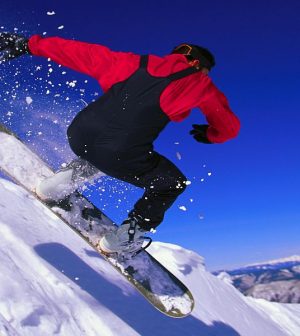- Skip Storing This Everyday Product in the Fridge Door
- Green Tea + B3 Pairing May Boost Brain Health
- Navigating Your Midlife Crisis: Embracing New Possibilities
- City Raccoons Showing Signs of Domestication
- Mapping the Exposome: Science Broadens Focus to Environmental Disease Triggers
- One Week Less on Social Media Linked to Better Mental Health
- Your Brain Changes in Stages as You Age, Study Finds
- Some Suicide Victims Show No Typical Warning Signs, Study Finds
- ByHeart Formula Faces Lawsuits After Babies Sickened With Botulism
- Switch to Vegan Diet Could Cut Your Greenhouse Gas Emissions in Half
Play It Safe With Winter Sports

Skiing, snowboarding, skating and sledding are great ways to have winter fun, but be sure to take steps to reduce your risk of injuries, experts say.
In 2017, U.S. emergency departments, doctors’ offices and clinics treated: 68,809 people for skiing-related injuries, 54,349 people for snowboard-related injuries, 52,308 people for ice skating-related injuries, and 4,499 people for toboggan-related injuries, according to the U.S. Consumer Product Safety Commission.
“Overexerting yourself on the slopes can lead to injuries ending your run for the season,” said Dr. Lori Reed, a spokesperson for American Academy of Orthopaedic Surgeons (AAOS).
“Individuals are at an increased risk of injuries such as sprains, strains, dislocations and fractures due to exhaustion,” Reed said in an academy news release. “You can prevent these by staying in good physical condition year-round and listening to your body. Don’t push your body when you are in pain or too tired.”
Here are winter sports safety tips from the AAOS:
- Stay in shape and condition muscles before starting winter sports. Warm up thoroughly before an activity. Cold muscles, tendons and ligaments are at increased risk for injury. Drink plenty of water before, during and after activities.
- Wear several layers of light, loose and water- and wind-resistant clothing. Layering allows you to adapt to your body’s changing temperature. Wear footwear that keeps your feet warm and dry, and has good ankle support.
- Take lessons from a qualified instructor, especially in sports such as skiing and snowboarding. Learning how to fall correctly can reduce the risk of injury. Check that equipment is in good working order and wear appropriate protective gear.
- Know and follow all rules of the sport. Don’t do a winter sport alone. Monitor for and heed warnings about storms and severe drops in temperature.
- Seek shelter and medical attention immediately if you or anyone else develops hypothermia or frostbite. Make sure everyone knows how to get help in the event of injuries.
More information
The Minnesota Department of Public Safety has more on outdoor winter safety.
Source: HealthDay
Copyright © 2025 HealthDay. All rights reserved.










